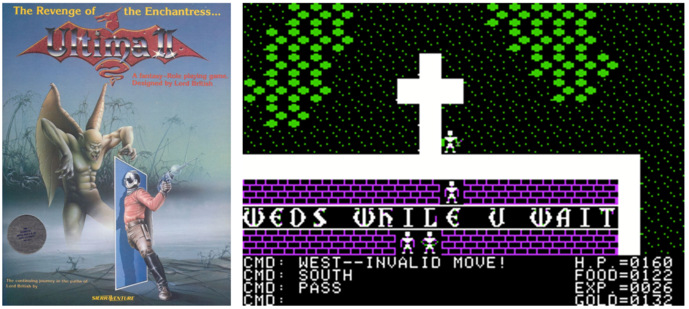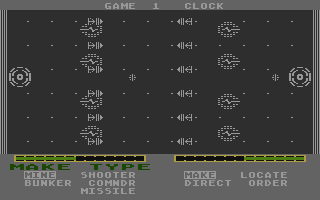Brief History of Computer Games: 1982
Transition to the next generation of 8-bit
![]() By: E. Bolognesi
By: E. Bolognesi
Published: 17 September 2019, 5:19 pm
This is the final chapter of the first part of my article about the history of computer games.
In 1982, the computer games business was a reality. Companies like On-Line Systems or Infocom had grown and were now able to increase the size of the teams working on their titles.
In March 1982, Sir-Tech released the second chapter of Wizardry, called Wizardry: Knight of Diamonds. The game was not changed much; we could define it as an expansion rather than a sequel, but it was more polished and with a better design. Like the predecessor, it was a commercial success.

The following month, Infocom released Deadline, one of the most advanced text-adventure ever realized, where time plays a fundamental role. The player only has 12 hours to solve the mystery, and every turn represents 1 minute. Instead of a static world that waits for the player to act, Deadline offers a much more realistic experience, with events that happen at a specific time, regardless of the player. Characters can also be interrogated using the new and advanced conversational model created by Infocom.
Deadline is also famous for another reason. It was the first game to offer a rich set of extras: several documents to help the player solve the case. All of them were included in the Documentary Evidence: memo, lab report, interviews with the characters, photos, and even the pills supposed to have killed the victim. That's why original copies of Deadline on eBay are pretty expensive.
The game was released in April 1982 for the Apple II and Atari 8-bit.

In May, one month later, Brøderbund released a game that would become one of the biggest Apple II hits of the year: Choplifter.
A programmer with a strong passion for helicopters, Dan Gorlin, started to develop his idea at the beginning of 1981. Initially, it was not a game but rather a helicopter simulator. He soon dropped the idea of the first-person 3D view, like Flight Simulator, and he opted for a more traditional side view. But despite the arcade look, he tried to replicate the physics of helicopter flight as much as possible. Then, inspired by the coin-up Defender, Gorlin added hostages to be saved, enemies, tanks, and planes.
But most importantly, he made the game a fantastic cinematic experience thanks to the detailed animations of the small sprites. The hostages react with emotions to the helicopter's arrival; some run, some wait, and others are thankful when they are saved. All of this was absolutely a novelty at the time, and the players were impressed.

After the Apple II release, Brøderbund ported Choplifter to Atari 8-bit, Commodore 64, and many other platforms. It was so successful that in 1985 SEGA acquired the rights to convert it into an arcade, making Choplifter the first, and one of the few, computer games to be ever converted to coin-up.
Wizardry II was not the only RPG sequel released in 1982. In August, Richard Garriott, after 18 months of development, was able to complete and release Ultima II: The Revenge of the Enchantress. It was a hugely ambitious project, and this time Garriott could not finish it alone. A team of developers and game designers helped him. Besides, the game was no longer written in BASIC; Garriott studied Assembly to program a faster game. BASIC was no longer a choice for commercial games. Like the predecessor, Ultima II was released for the Apple II and later ported to other platforms.

The same year, but in September, Infocom released another sequel: Zork III. After the not-so-convincing Zork II, released one year before, Marc Blank, Dave Lebling wrote the best chapter of the series with Zork III: The Dungeon Master.
As we know, Zork was not programmed in BASIC or Assembly; it was written in ZIL, a language created by Infocom to program adventure games. But to release a ZIL game on a specific platform, Infocom needed the virtual machine (called Z-Machine) to be available for that computer.
After the initial TRS-80 version, in 1982, Infocom created the Z-Machine for the Commodore 64, Atari 8-bit, and IBM PC. That's why Zork III was released almost simultaneously for all available home computers.

As we have seen, if we exclude Zork III, the most important games in 1982 were developed for the Apple II, again the most influential computer of the year. But it's worth mentioning a few titles that originated on the Atari 8-bit.
In 1982, a young Canadian programmer created, on its Atari 8-bit computer, a game called Formula 1 Racing. The success of this simple racing sim convinced the guy to found a company together with a former colleague and veteran Air Force pilot Bill Stealey. The company name was MicroProse, and the name of the young programmer was Sid Meier. I don't think he needs any introduction. If you are reading this, I am sure you have played Sid Meier's Pirates! or Sid Meier's Civilization at least once. In any case, don't worry; his name will appear very often from now on.
So yes, Sid Meier, creator of the Civilization series, one of the most appreciated and famous game designers ever, started programming on the Atari 8-bit.
Regarding MicroProse, as you know, it would become famous for the X-COM series and many other hits, especially simulators. The first game published by MicroProse was a flight combat sim programmed by Sid Meier called Spitfire Ace.

MicroProse initially focused on Atari 8-bit and Commodore 64, the home computers with the best technical specs. But Meier was programming only on the Atari 8-bit. It would take a few years before he began to code also the Commodore 64 versions of his titles. But we will talk about this later.
Another guy that started developing on an Atari 8-bit was Marc Russell Benioff. He was a high school student when he founded a small company called Liberty Software. He designed and programmed a few titles, including The Crypt of the Undead and The Nightmare (both released in 1982). Not many remember those games, and not many know that the same Marc Benioff, after working with Steve Jobs in the Macintosh team and later at Oracle, he's now the chairman and CEO of Salesforce. He has an $8 billion fortune. Not precisely part of the history of video games, but still an interesting fact, right?
In 1982 we also had the invention of a new genre. Dune II, released in 1992, is considered the game that made the RTS genre famous, and this is undoubtedly true. But real-time strategy games were invented much before. Cytron Masters for the Atari 8-bit, created by Danielle Bunten Berry in 1982, is the first example of this genre. To move all the units in real-time, Bunten had to use multi-thread software routines, a solution that was really ahead of its time. Just an example of how brilliant Bunten was, that, one year later, would create a real masterpiece called M.U.L.E.

After the Apple II and Atari 8-bit, the third platform was TRS-80, with over 243 titles, the highest number so far. But a computer without colors was destined to disappear soon, and the TRS-80 Color Computer, introduced in 1980, never became as popular as its predecessor.
But those three were not alone anymore. A new generation of home computers had already arrived, and they were growing.
But first, let me open a quick parenthesis about consoles because I need to mention Pitfall! by David Crane, co-founder of Activision. Developed initially for the Atari 2600, this game was a huge success, and it is considered the father of the side-scrolling platforming genre. Several computer versions were created in the following years. Pitfall was the second best-selling game on the Atari VCS, after Pac-Man (also released in 1982). The vast expectations regarding the sales of Pac-Man for the Atari 2600 were one of the reasons for the North American video game crash of 1983-1985. We will not talk about this here, but you can read everything on Wikipedia if you want.

Back to computers, 1982 was the year of the cheap machines: VIC-20 and ZX81. Commodore sold more than 800k VIC-20 in 1982. It was also the peak of game productions for the Sinclair ZX81. Despite the commercial success of the two products, driven by aggressive pricing, the hardware capabilities were minimal, so the games were extremely simple.
The two machines won't last long, but in a way, Commodore and Sinclair were preparing the field for something much more significant. In fact, in 1982, the two companies released two computers that were going to dominate the gaming scene in the following years: the ZX Spectrum and the Commodore 64.
Not many games were released for the two new platforms, but at least one made history: Football Manager, created by Kevin Toms. The game that invented the genre of soccer management sims was released first on the ZX81 and then improved with animated highlights and published for the ZX Spectrum in 1982.

This ends the first part of this history, where the Apple II was clearly the most influential platform. We didn't talk much about other computers, but there will be a lot to say about the C64 and ZX Spectrum, as well as about the BBC Micro, MSX, MS-DOS, and other platforms in the second part. Stay tuned!
